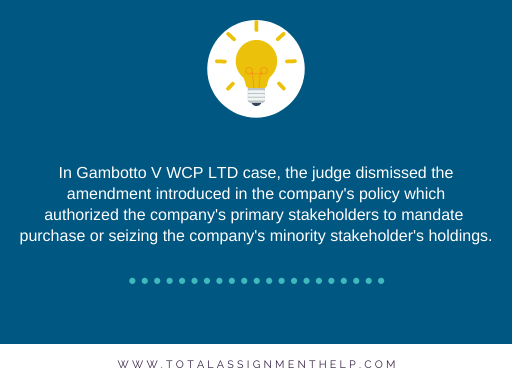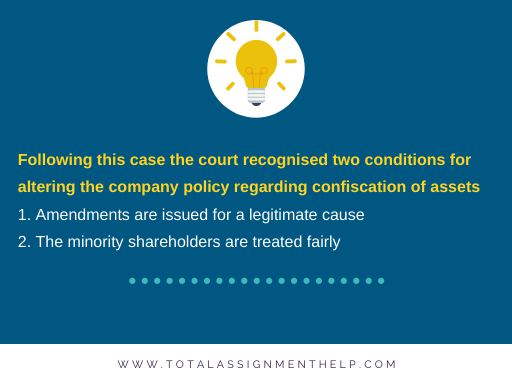Case Study On GAMBOTTO V WCP LTD
Question
Task: Understand Australia’s corporate statutes and analyse corporate executives' roles, privileges and obligations through the proceeding of the case of Gambotto V WCP LTD
Answer
Gambotto v WCP Ltd has been recognized as a significant proceeding in Australian practice of corporate legislation. In this case, the judge dismissed the alteration introduced in the company's bylaws since the modification authorized the company's primary stakeholders to mandate purchase or seizing the company's majority stakeholder's holdings.

However, on 8th March 1995, the judge acknowledged and supported the minority stakeholder's interest as per the Corporation Act. According to the Corporation Act, Mr. Giancarlo Gambotto represented himself and proved to be beneficial against Industrial Equity Ltd (IEL) for repossessing Mr. Gambotto 's assets in WCP as a minority stakeholder by modifying WCP's corporate bylaws. This success was seen as a noteworthy accomplishment as it demonstrates the authoritarian stance, typically discouraged in corporate sense by the judiciary.
The Australian High Court ruling was significant in the case of Gambotto V WCP LTD, as it adopted the new strict policy with the intention of assessing the reliability of such modifications made in the AOA and MOA corporations.

Information regarding Gambotto V WCP LTD:
Throughout this case, the proceedings were linked to the effort to acquire the 100 % interest in the WCP Ltd. by a large proportion. Out of that 100% the major subsidiary firms which were owned completely by IEL’s make for approximately 99.7 percent of the WCP's capital stock, and the claimant Giancarlo Gambotto and Eliandri Sandri holds approximately 0.094 percent of the WCP's outstanding shares. IEL wishes to retain 100 % ownership of WCP for the purpose of receiving taxes and regulatory advantages, which include savings of approximately $4 Million in their taxes and a reduction of approximately $3,000 per annum in their booking operations.
For this purpose it was conceivable for IEL to acquire the claimant’s assets in the course of an acceptable and required acquisition. To implement this action, IEL introduced into the company's bylaws, a clause that required any shareholder of the corporation holding 90 percent or more of the share capital to procure the holdings for the cost of $1.80 per share, on mandatory grounds before 30 June 1992. In order to notify the stakeholders of the board members' meeting that took place on 11th May 1992 to bring the change in the bylaws in effect, WCP Ltd. sent official notification letters to all the stakeholders. Analysts assessed the cost of the share at $1,365 per share and the claimant found this amount to be reasonable assessment. Complainants did not intend to sell their assets and press charges before the meeting against the recipient for the intention of stopping the amendment from being enacted. Thereafter, this meeting was held, but the Court ordered WCP that no stocks could be acquired by WCP on the grounds of this rationale until the court's ruling in this respect. Company represents the modification in the board meeting but IEL decided not to vote its assets in the discussion (Mitchell, 1994).
Initial Ruling:
According to justice McLelland J in the NSW Supreme Court, section176(1) of the Corporation Law granted the right to the company to make changes to the organisation's bylaws, however the power dynamic was limited by the rules of equity. He additionally claimed that the primary purpose of WCP's modification was to enable predominant stakeholders to take over the minority stakeholders’ holdings.
This modification resulted, in the court's view, in unfair discrimination of all the small investors who disagree to the ruling made in Gambotto V WCP LTD. Court concluded that if this provision was possible and if the dominant investors were permitted to acquire the small investors' assets, the process relating to mandatory purchase would've been inappropriate under sections 414 and 701 of the Corporations Law (Austlii, 1996).
Verdict from the Court:
The NSW Supreme Court reversed the decision made by the judgement of McLelland J, and Meagher JA took the main judgement in the case of Gambotto V WCP LTD. The judge argued that the corporation also had the right to modify their bylaws, but this right was limited by certain equality standards. Court also claimed that McLelland J’s opinion was only taking into account the aspect that perhaps the dispossession of assets was wrong in itself. Corporate law contained clauses specifically allowing such acquisitions, meaning dispossession wasn't really contradictory to regulations. Justice Meagher further claimed that the corporation might gain substantial advantages from acquiring the stakes, and the Court didnt take into account the point relating to the sum paid for the stocks to be insufficient. Hence no justification indicates why the Judge must interfere. For this Priestly JA concurred with Meagher JA 's ruling and confirmed the individual after being the organization representative and also accepted to bind by the corporation's newly approved motions. Furthermore, the amendment pertaining to acquiring the of assets succeeded by changing the Corporation's bylaws and it was treated as actual intent and not the dispossession against the minority stakeholders' wishes. Judge ruled that it was permissible for large proportion stakeholders to acquire the small percentage of shares as long as the corporation offered adequate financial compensation for the assets.

Decision made by the High Court:
The High Court reversed the Supreme Court's ruling by arguing that the corporation's modification was unconstitutional since this change was not produced with solid reasoning. This judgment was made by a majority of the jury memebers, Mason CJ, Brennan, Deane and Dawson JJ, who started their review by raising the issue of paramount significance regarding whether and in what circumstances, majority investors would take control by amending the bylaws to necessarily acquire small number of shares of the investors' on the grounds that it is unjust. Judges found the judgement given by Lindley MR in Allen v Gold Reefs of West Africa Ltd [1900] 1 Ch 656 at 671 for addressing this issue. Throughout the case of Gambotto V WCP LTD, Lindley MR claimed that the authority of the stakeholders to alter the corporation's bylaws by adopting a new provision must be implemented not only in compliance with the legal protocol as well as in the interests of the corporation itself. In regards to Peter's judgement in American Delicacy Co Ltd v Heath, the plurality of High Court justices in this dispute dismissed the idea that the check placed forward by Lindley MR in Allen as legitimate for the good of the corporation as a group was unacceptable when taking into account the shareholders' benefits and interests. Court distinguished among st the two forms of constitutional modifications. The judge noted that an adjustment that does not include the dispossession of stocks or lucrative contractual obligations linked to the assets could be enabled by standard resolution plan and that such a decision is not above any reason imagined in the company bylaws nor should it be unjust (Ramsay and Saunders, n.d.).
In contrast if the modification requires the confiscation of assets or other significant individual rights linked to the stocks then it would not be necessary to transfer the SR on a continuous basis, and it has been implemented on these various considerations. The large proportion of High Court judges specified three conditions to be checked out while amending the corporation's bylaws which allows the confiscation of assets, and the two tests are specified below:

- This control is exercised by the organization for legitimate cause.
- When the corporation uses its control it would not behave unpleasantly in context of the corporation's minority stakeholders.
The very first element of the check stating that the Corporation should be using this authority for a practical purpose implies that the confiscation of stocks can only be acceptable in the situation where it has been sufficiently proven that the ongoing stake in the corporation of the minority causes harm to the company's operations and activities and that the confiscation of stocks was appropriate in order to remove and mitigate the setback.
Majority therefore claimed that whether the confiscation of stocks promotes the best interest of the corporation or guarantees some economic benefit for the business, it will not be regarded as reasonable explanation. A confiscation of assets would be legitimate only when it protects the corporation from any damage. The majority of its members offer two explanations that explain the sense of reasonable intent, including when the existing shareholders invest in the business, when it was important to make sure that the corporation complies with legal requirements such as the investor's residence requirement.
The second component of the issues of justice that the confiscation of assets should be equitable and not coercive in nature , meaning that both statutory and constitutional considerations must be protected. The mechanism by which the confiscation was carried out must be reasonable, and the majority would reveal all the relevant details. It also involves expert panel assessment of the securities. On the other hand, practical justice requires value of shares to be compensated. A large percentage of shareholders claimed that actual value could not be regarded as a criterion adequate to assess the reasonable value of the stock. It should be acknowledged that other considerations such as corporate assets, payout, business structure and anticipated potential must be weighed. In the case of Gambotto V WCP LTD, the claimant did not question equality but it could not be proven that the confiscation of assets had been carried out for legitimate cause. The board also claimed that the duty to prove rests with the faction that wanted to redistribute in order to show that control was practiced lawfully.
Main components of the ruling:
The High court's ruling was regarded as a landmark judgment in Australia in the sense of corporate law and a few key components of the ruling for the case of Gambotto V WCP LTD are as follows:
- Initially, High Court aptly describes the appropriate reasoning and also specified the criteria called the rigorous test to fulfil the appropriate reasoning of confiscation of shares. The Court also noted that the objective test guarantees that the investigation is not limited in regards to the majority's shareholder's subjective best interests. It can be argued that the court had not formulated the check in such a manner that it is repulsive to board members in order to escape the safeguards specified in the legislative frameworks of confiscation. In the constitutional framework for the confiscation of assets the requirement for proper proposal specified by the High Court has no counterpart.
- Next, with the shareholder having ownership rights in the company, the majority of judges concentrated on the definition of stocks as assets. the court further indicated by the court the reasoning behind altering the bylaws of the company to initiate confiscation of shares was not accepted as proper reasoning by the court. They also claimed that there is ample reason relating to the dispossession of stocks that confiscation should be reasonable and also preserve the corporation's interest as both economic and cultural nature. The method, however, did not account for the property nature of the shares.
- Lastly, the good level of understanding set out in this scenario were deemed applicable only if they had been added by modifying the corporation's bylaws and do not extend from the corporation's inclusion to the law. If the firm's bylaws specified about the confiscation of stocks from the period when the organisation was formed then that clause is applicable in the legislation.

Conclusion:
Analysts said ruling made in the case of Gambotto V WCP LTD has been the most significant legal procedure in Australia's corporate law context, as this judgment encourages the corporation's small investors. In this event, High Court not only compelled the small investors but also imposes liability on the major shareholders and the corporation’s board members to perform the confiscation of stocks only for the legitimate cause, and not for the benefits of major investors. Within that High Court secured the rights of the minority stakeholders.

The court's ruling was seen as a major win for the corporation's existing stakeholders. For this courts offer control to the corporation's small investors. The judgment in the case of Gambotto V WCP LTD is seen as a major step for the security of the firm's small investors.
References:
Allen v Gold Reefs of West Africa Ltd [1900] 1 Ch 656 at 671.
American Delicacy Co Ltd v Heath (1939) 61 CLR 457 at 481.
Austlii, (1996). Oppression of Majority Shareholders by a Minority? Gambotto v WCP Ltd. Retrieved on 17th November 2017 from: https://www.austlii.edu.au/au/journals/SydLRev/1996/6.pdf.
Corporation Act 2001- Section 414.
Corporation Act 2001- Section 701.
Gambotto v WCP Ltd (1995) 182 CLR 432; 127 ALR 417; 16 ACSR 1; 13 ACLC 342.
Mitchell, V (1994). Gambotto and the Rights of Minority Shareholders. Retrieved on 17th November 2017 from: https://epublications.bond.edu.au/cgi/viewcontent.cgi?article=1091&context=blr.
Ramsay, I.& Saunders, B. What do you do with a high court decision you don’t like? .legislative, judicial and academic responses to Gambotto V WCP Ltd. Retrieved on 17th November 2017 from: https://law.unimelb.edu.au/__data/assets/pdf_file/0006/1709610/42-WhatDoYouDoWithAHighCourtDecisionYouDontLike1.pdf.












